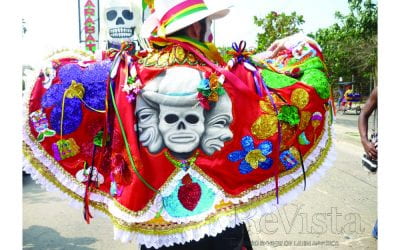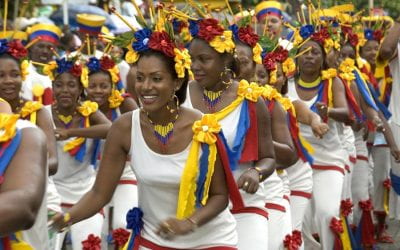Carnival Inc.
Public Space and Private Enterprise
In the rainy season, streams of water take over Barranquilla. Streets transform into abundant, improvised rivers. They stop traffic, spilling over onto the sidewalks; they tumble trees, cars and pedestrians. The city—which does not have an adequate sewage system—gets paralyzed, waiting for the rains to stop. In the same manner, in the dry season, the carnival processions take over Barranquilla. Rivers of people spill out onto the streets with an enthusiasm that overflows the official fiesta, erupting into a multiplicity of neighborhood fiestas, celebrations on every corner and local dance teams known as comparsas. Like the downpours, carnival also overflows the riverbeds.
“To enjoy it, you’ve got to live it” is the Barranquilla motto. Because of this, we accepted with enthusiasm when León—the leader of the cumbia group Candela Viva—invited us to participate in the parade. The rehearsals took place at night in a chaotic hubbub of flirting couples who chatted and tried out different choreographies, neighbors drinking at the corner store with music blaring, and children playing soccer as women were putting on the final touches to their wide cumbia skirts. When we asked León why there were so many alternative parades competing with the official programming, he did not waste a minute in attributing the blame to Carnival Inc. (in Spanish, Carnaval S.A.).
In 1991, local elites founded the mixed state-private company Carnival of Barranquilla Inc. and privatized the festive event, citing the need to save it from the political patronage system (clientelismo), corruption and decadence. In public hands the carnival had been considered electoral loot rather than a space for an active citizenry. Once the carnival was in private hands, it became an expense rather than an investment, leading to a scramble for profitability. Admission tickets were sold, fees charged for popular dances, seats and stages installed. The parades were invaded by commercial guidelines and corporate advertising displayed on tractor-trailers. In short, a collective festival was transformed into an economic engine for profit.
At first, most viewed the transfer from public to private hands as a step toward increasing efficiency and transparency in the management of carnival resources, as a break with a long-established game of political intrigue. Important sectors of the carnival-makers, however, grew more and more disgruntled. The carnival, they said, had fallen under the exclusive control of a profit-seeking social elite. Several rebel groups emerged and began to set up their own carnivals, in open opposition to Carnival Inc.’s management. “The first and most important dissident parade was on 44th Street, which in 1999 challenged the main official event, the Battle of the Flowers (Batalla de Flores), which goes down 40th Street. The competition’s leader Edgar Blanco says: “So we held our carnival parade on Saturday on 44th Street. We thought 40th Street would draw off some of our audience, but nothing of the sort. People came out. Within certain limits: there wasn’t much music, the costumes weren’t great, a lot of problems…but people came out. It was encouraging for us. We had a good crowd, however there was criticism: ‘What a poor parade’ …. They started saying that the carnival on 40th Street was for the rich and ours for the poor, that ours was very poor.”
Actually, the carnival’s commercialization is not a recent phenomenon. Way before the creation of Carnival Inc., the official slogan in the 1950s was “Carnival is celebrated with Águila” (the country’s leading brand of beer). Nowadays everybody knows “Quien lo vive es quien lo goza” (To enjoy it, you’ve got to live it or, literally, Those who live it are those who enjoy it), but few know that this slogan is of recent vintage, the fruit of a 1990s advertising campaign. As Diana Acosta, Barranquilla’s former Secretary of Culture, recounts: “I attended that meeting for a tourism advertising campaign. The initial proposal was El que viene es el que goza [You’ve got to come to enjoy it]. Since we Barranquillans are so suspicious and dirty minded, we said no way, that won’t do, because people are going to change it to El que se viene es el que goza[You’ve got to cum to enjoy it]. So we ended up with Quien lo vive es quien lo goza.”
What we believe to be a popular saying that dates back to ancient times is in fact the result of recent marketing for tourism, whereas what is considered a recent advertisement had in fact accompanied the festival for more than half a century.
The debate on commodification reached a turning point in 2003, when UNESCO declared the Carnival of Barranquilla a Masterpiece of the Oral and Intangible Heritage of Humanity. Most carnival-makers cheered the international award, since the designation of cultural heritage seemed to guarantee a way out from both state-based corruption and unruly merchandizing. The news was enthusiastically received all over Colombia, and no initiative involving the carnival—whether official or alternative—has since failed to boast of the prestigious acknowledgment. The “Cultural Heritage of Humanity” label now certifies the Carnival of Barranquilla as a national icon worthy of display before the world.
Nevertheless, even today, a decade after the announcement, the enormous expectations have yet to be met. The controversies, moreover, have only become more insurmountable with the passing years. The entities charged with carrying out the plans to safeguard the carnival are at loggerheads, some of their functionaries have been questioned, and the communities who stage the event have remained divided. How could a distinction conferred by a prestigious international organization like UNESCO—a supposedly well-intentioned and invigorating, or at worst innocuous, initiative—spawn so many problems?
One of the major reasons has to do with reticence over economic matters related to the issue of cultural heritage. UNESCO took an ambiguous stance on the unending debate whether private interests or public entities should control the festival. While devoting dozens of pages to a meticulous folkloric description of endangered traditional dances, the UNESCO dossier refers only briefly and in general terms to the excessive and inappropriate commercialization that folk groups are forced to accept to guarantee their presence in the great parades.
The UNESCO document makes note of the alienation produced by the commodification of culture, but perceives its causes as external: “The globalized world and the penetration of a homogenizing culture imposed by first-world countries are exerting pressure on this cultural space to imitate other carnivals that have managed to enter the industry of universal culture and are founded on the theory of spectacle, which distorts the essence of traditional aesthetic creations.”
What is most striking in the UNESCO dossier is what goes unsaid: privatization, one of the underlying issues running through the carnival. Consider the traditional dances in danger of extinction. Since they attracted the attention of UNESCO, they have been the subject of dispute between the various parades. Edgar Blanco observes: “Then UNESCO came along with the Intangible Cultural Heritage of Humanity stuff. They noticed that there were a lot of dances headed for extinction, and it turned out all those dances were in our parade.… All of sudden people stopped calling it poor and started saying, ‘Hey, UNESCO says we have to help those people, so they don’t go extinct.’ And then the companies started coming, offering fabrics and this and that.”
The danza de trenzas (braid dance) of the Chamila Indians, for example, is considered by UNESCO as one of the carnival’s oldest and most traditional expressions, deriving from indigenous dance rituals as practiced by pre-Columbian cultures inhabiting the basin of Lower Magdalena (River) Province. It is one of the crown jewels of the 44th Street parade, which managed to snatch it away from the “official” 40th Street parade.
However, Dora Tomás Meléndez, the dance’s current “authorized” depositary, freely admits that it is a tradition invented in 1936 by her mother, who, far from being indigenous, was a rural settler living on the Islas del Rosario off Cartagena. This same Dora Tomás brought the dance to Barranquilla 42 years ago. She had formerly taken part in the 40th Street parade but left when it stopped paying her. She moved to the 44th Street parade 28 years ago with emergence of the dissidents. The two parades are still fighting over her.
Unable, after hard-fought battles and counter-vetoes between the local stakeholders, to execute the Ten-Year Safeguarding Plan provided for in UNESCO’s declaration, the Ministry of Culture proposed a new plan in 2010. An outside interdisciplinary consulting team was appointed to reach an institutional and social agreement on the matter, and I was asked to coordinate it.
A vast process for a collective construction of the proposal followed, involving hundreds of people who actively participated in workshops and meetings over more than six months. Despite reciprocal diffidence, complaints, and allegations—even episodes of boycotts and personal insults hurled at some radical sectors— the process was successful in building up a Safeguarding Plan with the contributions of all participants.
Some very polemic points were approved. No wonder the toughest debate among the participants dealing with the construction of the Special Safeguarding Plan was about Carnival Inc. The final decision was to abolish it, even if it was clear to everybody that it was merely a symbolic gesture, since nowadays the Carnival of Barranquilla Foundation runs the business. Nevertheless, the Minister of Culture expressed her total disagreement with that decision and the results of the collective participatory process, arguing that patrimonial preservation deals with folklore and tradition, and has nothing to do with social, political or economic matters. Suddenly the whole process was blocked, and the collective decisions reversed.
In May 2012, the Administrative Tribunal of the Atlantic Coast ordered that the Carnival of Barranquilla be managed by the public sector, since it had been declared Cultural Heritage of the Nation and Humanity. The court decision was made in response to a lawsuit filed by Blanco and two other individuals. Several folklore groups, associations and commentators supported this decision. “The Carnival is privatized and its organizers throw the people of Barranquilla a bone, while they get to devour the meat,” said one councilman. Others agreed that Carnival Inc. should not manage the Carnival, and that the judges were merely reaffirming Article 72 of the Colombian Constitution: “Cultural patrimony of the nation is under the protection of the state.”
For its part, Carnival Inc. received support from business people, trade associations and different folklore groups. Alberto Gómez, the Carnival Foundation spokesman, recalled, “Twenty years ago, no one wanted to organize the Carnival because it was expensive and resources were lacking. That was when Carnival Inc. was created to operate the fiesta, prior to the recognition of the Carnival as national patrimony.…We have a serious and responsible track record in handling economic resources, which allows us to support the district in financing its fiesta, which is the most difficult part of organizing the Carnival.”
In a meeting called by Mayor Elsa Noguera, the members of the board of directors finally declared that they would continue to manage Barranquilla fiestas, taking advantage of the totally confusing wording of the legal verdict.
More than affecting future practical consequences of the festival, the court decision negated the stance of the former Minister of Culture in a forceful way. She had insisted that the Special Safeguarding Plan did not have to get mixed up with questions of an economic, social and political nature and should be restricted to the preservation of a cultural heritage narrowly defined by its folkloric dimension. There is a certain bittersweet uneasiness in the fact that crucial affairs regarding the fiestas end up in the hands of lawyers and judges, when they have already been the subject of collective agreements in the scope of a participative citizens’ process.
We still don’t know the implications of the court sentence for the future of the Carnival of Barranquilla, and the topic is still a hot one in the media and in meetings of folkloric groups. So far, nobody has been able to break the deadlock. An embarrassing situation indeed: the best-known and world-famous manifestation of Colombian culture, declared a Masterpiece of the Oral and Intangible Heritage of Humanity, is among the few in the whole country without an operational Safeguarding Plan. Edgar Blanco, who participated in the process, now denounces it: “We—the ones who are truly called to handle humanity’s cultural heritage—are those who are truly responsible for the tradition in the first place. I mean, if it is we who know the threats to our cultural identity, who have been making proposals for the past 28 years, and who have kept ourselves intact, then it is we who should handle our cultural heritage. But who, in fact, is handling it? …. Those people at Carnival Inc. The deal there is that Carnival Inc. is represented by the political class of Barranquilla, who are the multinationals’ best friends.… They don’t know shit, but they know where to find money. That’s the scam around the Carnival. And we’ve fought against it. We’ve made a stand. I mean, the UNESCO declaratory is just a flag: we are the cultural heritage of humanity, but privatization continues. It’s not good. It’s like having your mother, but dead.”
When I asked him how he envisioned the Carnival in ten years, his answer disconcerted me: “We want to organize a Carnival of Carnivals to safeguard the tradition. The idea is to place viewing boxes at eight locations with a capacity of 30,000 people. We will broadcast live for four hours. We’ll present the best conga musicians—with a sound of 30 to 40,000 watts—in the style of Brazilian floats. An immense affair with thousands of congas, dancing in the traditional way. And another float with cumbia, with 500 couples dancing cumbia. Like in the sambodromo in Rio de Janeiro. We’re going to stage a night event and charge 30,000 pesos [$US15] to get in. When these plans get known…an event like that would kill off Carnival Inc.”
Up until that moment in the interview, I’d formed the idea that his struggle was against the commercialization of the fiesta, but in reality his great dream was to go into big business on his own. So the old paradox returned: a collective fiesta, representing a common legacy and staged in the city’s public space, ends up being managed by a private entity. How to get out of this impasse?
Perhaps the most promising path would be to go further than the public-private dichotomy and to think about the festival as a common good. The growing global movement in defense of common goods opens up an epistemological horizon that has not been explored very much in terms of managing fiestas. Let us go back to participatory processes with powers of decision: there—I tell myself—lies the key to returning the Carnival of Barranquilla to its character of being a common good.
After almost four hours of dancing cumbia in the streets between two wings of a rowdy multitude, the exhausted comparsa dancers dispersed throughout the city like river water flowing into the open sea. León, euphoric because of the great performance of Candela Viva, approached us. “We can count on you for Monday, right?” he asked. “We’re going to parade in the traditional comparsa on 40th Street.” “40th Street?” I replied. “Isn’t that the official carnival? I thought Candela Viva was not going to participate in the parades of Carnival Inc.” “Well, yes and no,” he said. “What’s happening is that we want to win the Gold Congo, you know, because of that stuff about patrimony.”
Around me, the plaza was filled with dancers and masked revelers, drinking and massaging their feet, exhausted, smiling. Well, I thought, one thing is certain: To enjoy it, you’ve got to live it….
Spring 2014, Volume XIII, Number 3
Paolo Vignolo, with a Ph.D. in History and Civilization at the E.H.E.E.S of Paris, is Associate Professor at the Center of Social Studies of the National University of Colombia, Bogotá. He was a 2012-13 Julio M. Santo Domingo Visiting Scholar at the David Rockefeller Center for Latin American Studies.
Related Articles
Festival and Massacre
Festivals are privileged spaces to help us understand the meaning of community. They are a special way of presenting historical narratives, bringing…
Fiesta and Identity
English + Español
In Barranquilla the days of Carnival begin early. From the first hours of the day—already confused with the last hours of the night—the smells of celebration are in the air. The streets…
Fiestas: Editor’s Letter
At the Oruro Carnival, a few hours from La Paz, the heavy-set blue-skirted women swirl past me in a dizzying burst of color and enviable grace. The trumpeters, some with exotically dyed hair, blare not too far behind. I remember that as a young man President Evo Morales had been a trumpeter in this very carnival.





